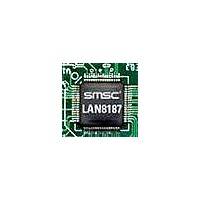LAN8187-JT SMSC, LAN8187-JT Datasheet - Page 51

LAN8187-JT
Manufacturer Part Number
LAN8187-JT
Description
Ethernet ICs HiPerfrm Ethrnt PHY
Manufacturer
SMSC
Type
MII/RMII Ethernet Transceiverr
Datasheet
1.LAN8187-JT.pdf
(78 pages)
Specifications of LAN8187-JT
Ethernet Connection Type
10 Base-T, 100 Base-TX
Minimum Operating Temperature
0 C
Mounting Style
SMD/SMT
Product
Ethernet Transceivers
Number Of Transceivers
1
Standard Supported
802.3ab
Data Rate
10 MB, 100 MB
Supply Voltage (max)
3.3 V
Supply Voltage (min)
1.8 V
Supply Current (max)
39 mA, 81.6 mA
Maximum Operating Temperature
+ 70 C
Package / Case
TQFP-64
Lead Free Status / RoHS Status
Lead free / RoHS Compliant
Available stocks
Company
Part Number
Manufacturer
Quantity
Price
Company:
Part Number:
LAN8187-JT
Manufacturer:
Standard
Quantity:
1 040
Company:
Part Number:
LAN8187-JT
Manufacturer:
STM
Quantity:
5 362
Part Number:
LAN8187-JT
Manufacturer:
SMSC
Quantity:
20 000
±15kV ESD Protected MII/RMII 10/100 Ethernet Transceiver with HP Auto-MDIX & flexPWR
Datasheet
SMSC LAN8187/LAN8187i
5.3.2.1
5.4
5.4.1
5.4.2
30.5
30.4
30.3
30.2
30.1
29.5
29.4
29.3
29.2
29.1
Note: The ENERGYON bit 17.1 is defaulted to a ‘1’ at the start of the signal acquisition process,
Example Alternative Interrupts system
For example 30.7 is set to ‘1’ to enable the ENERGYON interrupt. After a cable is plugged in,
ENERGYON (17.1) goes active and nINT will be asserted low.
To de-assert the nINT interrupt output, either.
1. Clear the ENERGYON bit (17.1), by removing the cable, then writing a ‘1’ to register 29.7.
2. Clear the Mask bit 30.1
Carrier Sense
The carrier sense is output on CRS. CRS is a signal defined by the MII specification in the IEEE 802.3u
standard. The PHY asserts CRS based only on receive activity whenever the PHY is either in repeater
mode or full-duplex mode. Otherwise the PHY asserts CRS based on either transmit or receive activity.
The carrier sense logic uses the encoded, unscrambled data to determine carrier activity status. It
activates carrier sense with the detection of 2 non-contiguous zeros within any 10 bit span. Carrier
sense terminates if a span of 10 consecutive ones is detected before a /J/K/ Start-of Stream Delimiter
pair. If an SSD pair is detected, carrier sense is asserted until either /T/R/ End–of-Stream Delimiter
pair or a pair of IDLE symbols is detected. Carrier is negated after the /T/ symbol or the first IDLE. If
/T/ is not followed by /R/, then carrier is maintained. Carrier is treated similarly for IDLE followed by
some non-IDLE symbol.
Collision Detect
A collision is the occurrence of simultaneous transmit and receive operations. The COL output is
asserted to indicate that a collision has been detected. COL remains active for the duration of the
collision. COL is changed asynchronously to both RX_CLK and TX_CLK. The COL output becomes
inactive during full duplex mode.
COL may be tested by setting register 0, bit 7 high. This enables the collision test. COL will be asserted
within 512 bit times of TX_EN rising and will be de-asserted within 4 bit times of TX_EN falling.
In 10M mode, COL pulses for approximately 10 bit times (1us), 2us after each transmitted packet (de-
assertion of TX_EN). This is the Signal Quality Error (SQE) signal and indicates that the transmission
was successful. The user can disable this pulse by setting bit 11 in register 27.
Miscellaneous Functions
Remote Fault Detected
Parallel Detection Fault
Auto-Negotiation Page
Auto-Negotiation LP
therefore the Interrupt source flag 29.7 will also read as a ‘1’ at power-up. If no signal is
present, then both 17.1 and 29.7 will clear within a few milliseconds.
Acknowledge
Or
Link Down
Received
Table 5.47 Alternative Interrupt System Management Table.
5.14
1.4
1.2
6.4
6.1
DATASHEET
Parallel Detection
Page Received
Remote Fault
Acknowledge
Link Status
Fault
51
®
Technology
Rising 5.14
Falling 1.2
Rising 6.1
Rising 1.4
Rising 6.4
5.14 low
1.2 high
1.4 low
6.4 low
6.1 low
Revision 1.7 (03-04-11)
29.5
29.4
29.3
29.2
29.1













